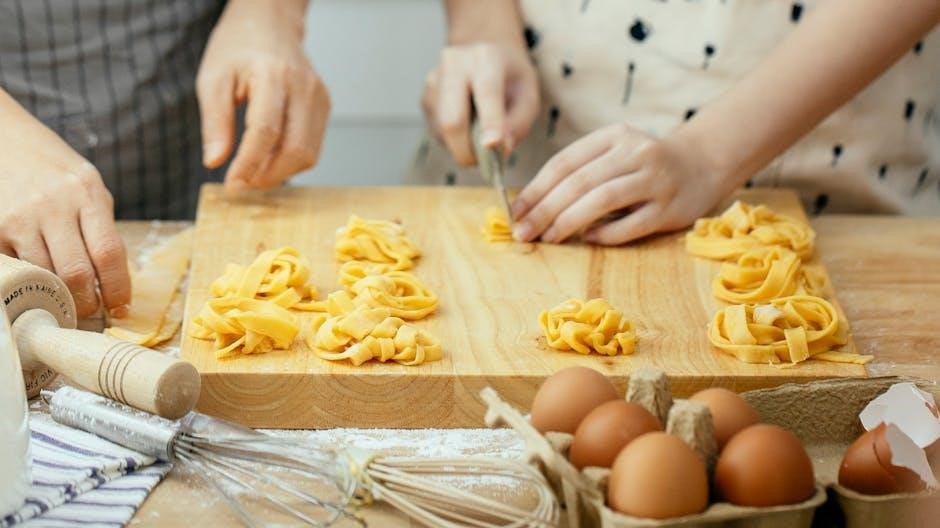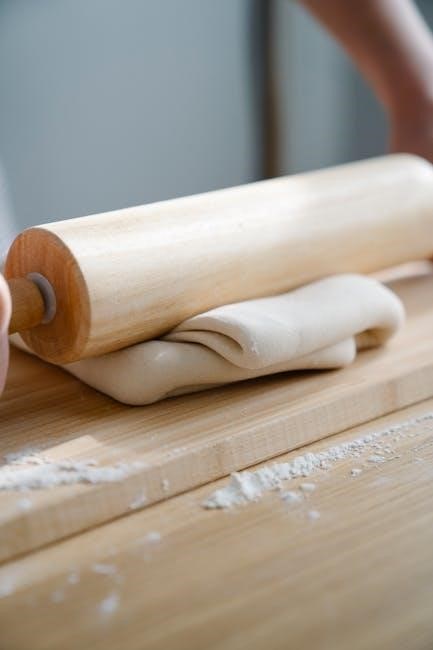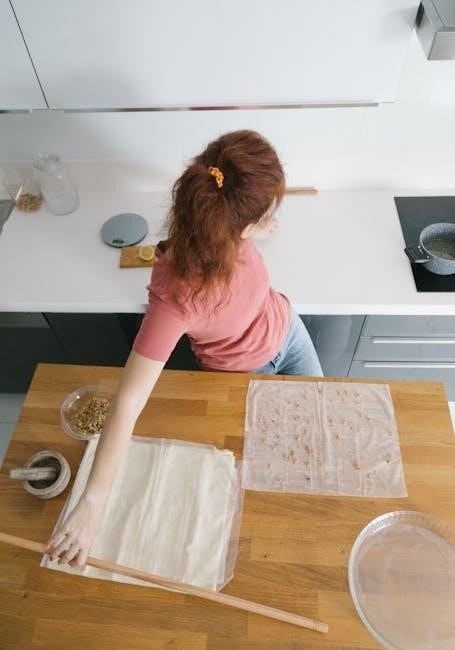rolling pin guides
Rolling pin guides are essential tools for achieving uniform dough thickness․ They ensure consistency and efficiency in baking, helping to produce high-quality pastries and cookies every time․
1․1 What Are Rolling Pin Guides?
Rolling pin guides are accessories designed to fit onto rolling pins, helping users achieve precise dough thickness․ They are typically rings, bands, or spacers made from materials like silicone, plastic, or 3D-printed designs․ These guides slide onto the ends of the rolling pin, ensuring the dough is rolled out evenly to a specific height․ They eliminate guesswork, making it easier to achieve consistent results for baking tasks like cookies, pastries, or pie crusts․ This simple tool enhances accuracy and efficiency in the kitchen․
1․2 Importance of Consistent Dough Thickness
Consistent dough thickness is crucial for achieving uniform baking results․ It ensures that cookies, pastries, and crusts bake evenly, preventing some areas from being overcooked while others remain undercooked․ Uniform thickness also maintains the desired texture and appearance of baked goods․ For cutout cookies and delicate doughs, consistent thickness is essential to prevent warping or breaking during baking․ This precision is key to achieving professional-looking results and ensuring recipes turn out as intended every time․
Types of Rolling Pin Guides
Rolling pin guides come in various forms, including silicone rings, 3D printed guides, and adjustable plastic strips․ Each type offers flexibility and precision for consistent dough thickness․
2․1 Silicone Rolling Pin Guide Rings
Silicone rolling pin guide rings are flexible, slip-on accessories made from durable silicone․ Available in various sizes and colors, they fit snugly over the ends of rolling pins․ These rings prevent the guides from shifting during use, ensuring consistent dough thickness․ Easy to clean and dishwasher-safe, they are ideal for both home bakers and professionals․ Their versatility and ease of use make them a popular choice for achieving precise, uniform results in baking․

2․2 3D Printed Rolling Pin Guides
3D printed rolling pin guides are custom-made to fit your rolling pin perfectly․ They are designed using precise measurements to ensure a snug fit and are typically made from durable materials․ These guides are ideal for bakers who prefer tailored solutions, as they can be adjusted to specific thicknesses and styles․ Available on platforms like Etsy, they offer a modern, innovative way to achieve consistent dough thickness, combining functionality with a personalized touch for professional-grade baking results․
2․3 Adjustable Plastic Strips
Adjustable plastic strips are a practical and versatile option for achieving consistent dough thickness․ These strips can be placed on either side of the rolling pin and adjusted to the desired width․ They are easy to use and come in various thicknesses, making them suitable for different types of dough․ Durable and reusable, they provide a cost-effective solution for home bakers and professionals alike, ensuring even rolling and precise results every time․

DIY Rolling Pin Guides
Create custom DIY rolling pin guides using wood dowels, sandpaper, and a saw․ Sand the dowel, mark desired thickness, and fit it snugly for precise control during rolling․
3․1 Materials Needed
To create your own DIY rolling pin guides, you will need a wood dowel, sandpaper, a saw, wood glue, a drill, clamps, a ruler, and a pencil․ The dowel serves as the main component, while sandpaper smooths the surface․ Use the saw to cut the dowel to your desired length․ Wood glue and clamps help secure any additional attachments․ A ruler ensures precise measurements, and a pencil marks the thickness guide․ These materials are readily available and allow for a customizable, durable rolling pin guide tailored to your baking needs․
3․2 Step-by-Step Instructions

Begin by cutting the wood dowel to your desired length using a saw․ Sand the cut ends to ensure smoothness․
Measure and mark the thickness guide on the dowel using a pencil․
Lightly sand the marked areas to create a rough surface for better adhesion․
Attach the guides using wood glue, ensuring they align with your marks․ Clamp and let dry․
Once dry, test the guides by rolling out dough to ensure even thickness․
This simple process allows you to create a customized rolling pin guide tailored to your baking needs․

Benefits of Using Rolling Pin Guides
Rolling pin guides ensure even dough thickness, promoting consistent baking results․ They minimize waste and save time by eliminating constant adjustments, making the baking process more efficient and precise․
4․1 Ensuring Even Baking
Rolling pin guides are crucial for achieving even baking by maintaining consistent dough thickness․ This ensures that heat is distributed uniformly, preventing overcooking or undercooking․ With even thickness, cookies and pastries bake at the same rate, resulting in a professional finish․ The guides eliminate guesswork, guaranteeing that each piece of dough meets the recipe’s requirements․ This consistency is especially vital for cutout cookies, where uneven thickness can lead to warping or inconsistent textures․ By using rolling pin guides, bakers can achieve perfectly baked goods every time․
4․2 Minimizing Waste
Rolling pin guides help minimize waste by ensuring precise dough thickness, reducing uneven scraps․ This prevents overworking the dough and avoids excess material․ By maintaining consistent thickness, bakers can use dough more efficiently, reducing the need for additional rolls or adjustments․ This tool is especially useful for large batches, where waste accumulation can be significant․ With guides, bakers achieve the desired thickness effortlessly, saving both time and materials, and ensuring every piece of dough is used effectively․ This makes the baking process more sustainable and cost-effective․
4․3 Time-Saving
Rolling pin guides streamline the baking process by eliminating the need for constant thickness checks․ With guides in place, achieving consistent dough thickness becomes effortless, saving valuable time․ Bakers can roll out dough efficiently without pausing to measure or adjust, making the process quicker and more straightforward․ This tool is especially beneficial for large batches or intricate recipes, where time is of the essence․ By reducing manual adjustments, rolling pin guides help bakers work more efficiently, allowing them to focus on other tasks while maintaining high-quality results․

How to Choose the Right Rolling Pin Guide
Selecting the right rolling pin guide involves measuring your pin’s diameter and determining the desired dough thickness․ This ensures a proper fit and optimal performance for consistent results․
5․1 Measuring Your Rolling Pin
Measuring your rolling pin is crucial for selecting the right guide․ Use calipers or a precise measuring tool to determine the pin’s diameter and length․ Ensure the guide’s inner recess matches the pin’s measurements for a snug fit․ Incorrect sizing can lead to guides shifting during use, affecting dough consistency․ Measure both ends, as some pins may have slight variations․ Accurate measurements ensure optimal performance and even dough thickness․ This step is essential for achieving professional-quality baked goods every time․
5․2 Selecting the Correct Thickness
Selecting the correct thickness for your rolling pin guide ensures even dough rolling and professional results․ Choose guides based on your recipe’s requirements, as different doughs need specific thicknesses․ For example, cookie dough often requires 1/4″ or 5/16″ guides, while pie crusts may need thicker settings․ Consider the desired texture and bake consistency․ Match the guide to your rolling pin’s diameter for proper fit․ This step ensures uniform thickness, preventing overcooked or undercooked areas․ Proper thickness selection enhances baking outcomes and maintains dough integrity․
Proper Use and Maintenance
Proper use and maintenance ensure longevity and effectiveness․ Always align guides securely, clean with mild soap, and store in a dry place to prevent damage․

6․1 Fitting the Guides
Fitting the guides properly is crucial for their effectiveness․ Start by measuring your rolling pin’s diameter using calipers or a precise measuring tool․ This ensures the guides fit snugly without shifting during use․ Slide the guides onto the rolling pin, aligning them evenly on both ends․ A secure fit prevents the guides from moving, ensuring consistent dough thickness․ For adjustable plastic strips, tighten them firmly once in place․ Properly fitted guides enhance control and accuracy, making the rolling process smoother and more efficient․ This step is essential for achieving uniform results in baking․
6․2 Cleaning and Storing
Regular cleaning and proper storage are essential for maintaining the longevity of rolling pin guides․ Silicone guides can be washed with mild soap and warm water, then dried thoroughly to prevent mold․ Plastic or 3D printed guides should be wiped with a damp cloth and dried․ Avoid harsh chemicals, as they may damage the materials․ Store the guides in a cool, dry place, away from direct sunlight, to prevent warping or cracking․ Keeping them in a protective case or pouch can also prevent scratches and ensure they remain in good condition for future use․
Advanced Techniques
Advanced techniques involve combining rolling pin guides with textured pins for intricate designs and using them with various dough types for consistent results across different recipes․
7․1 Combining Guides with Textured Rolling Pins
Combining rolling pin guides with textured rolling pins enhances both design and consistency․ Textured pins add intricate patterns to dough, while guides ensure uniform thickness․ This technique is perfect for creating decorative cookies or embossed bread rolls․ By maintaining even dough height, guides prevent warping during baking․ The result is professional-looking baked goods with precise designs․ This method is ideal for holiday cookies or custom cakes, offering both aesthetic appeal and structural integrity․ It’s a creative way to elevate baking while maintaining efficiency and precision․
7․2 Using Guides for Different Dough Types

Rolling pin guides are versatile for various dough types, ensuring consistent thickness regardless of the recipe․ For cookie dough, guides help maintain precise measurements, preventing overcooked edges․ With pizza dough, they ensure an even base for uniform crispiness․ Yeast doughs benefit from consistent rolling, promoting even rising․ Adjustable guides accommodate different thickness needs, from delicate pastries to hearty bread rolls․ This adaptability makes guides indispensable for bakers tackling diverse recipes, ensuring each dough type meets its ideal thickness for optimal results․
Rolling pin guides are indispensable tools for achieving precise dough thickness, ensuring consistent results in baking․ They offer versatility for various dough types, from delicate pastries to hearty bread rolls, and simplify the rolling process․ By minimizing waste, saving time, and promoting even baking, these guides enhance both amateur and professional baking experiences․ Their adaptability and ease of use make them a valuable addition to any baker’s toolkit, helping to create high-quality treats with ease and confidence․

